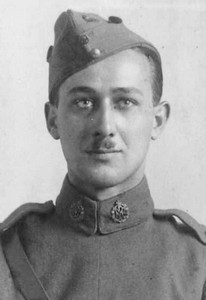William Frederick James Harvey DFC & Bar MC MBE was a British flying ace in World War I credited with twenty-six victories. He was the first recipient of the DFC & Bar and was also awarded the MC.
Captain Samuel Frederick Henry "Siffy" Thompson was a British World War I two-seater fighter ace who, in conjunction with his observer-gunners, was credited with thirty aerial victories before being shot down and killed. Despite having an active fighter career of only five months, he reached the rank of captain and won two British military decorations.
Captain Dennis Latimer was a British World War I flying ace notable for achieving twenty-eight aerial victories, all against enemy fighter aircraft.
Ronald Malcolm Fletcher was an English World War I observer/gunner ace in two-seater fighters who, in conjunction with his pilot, Lt. Samuel F.H. Thompson, gained 26 confirmed victories. He was notable for the fact that all but one of these victories were over enemy fighter aircraft.
Lieutenant Llewelyn Crichton Davies was a Welsh World War I flying ace credited with five aerial victories.
Captain Walter Alfred Southey was a British First World War flying ace, credited with twenty aerial victories, including five balloons, making him the second highest scoring ace in No. 84 Squadron, behind Andrew Beauchamp-Proctor.
Captain George Everard Gibbons was a British World War I flying ace credited with 18 aerial victories gained while flying a Bristol F.2 Fighter in 1918. Both of his observers, Sidney Knights and Thomas Elliott, also became aces flying with him. Gibbons' final tally consisted of three enemy aircraft destroyed by fire, five others destroyed, and ten driven down out of control.
Lieutenant Donald Wainwright Beard was a British World War I flying ace credited with eight aerial victories.
Lieutenant David John Weston was a British World War I flying ace credited with thirteen aerial victories. All of his wins were over enemy fighter planes.

Captain Douglas Graham Cooke was a British World War I flying ace credited with thirteen aerial victories.
Lieutenant Ernest Hardcastle was an English World War I flying ace observer/gunner credited with twelve aerial victories. He would return to military service during World War II.
Air Marshal Sir Victor Emmanuel Groom, was a senior officer in the British Royal Air Force and a flying ace of the First World War credited with eight aerial victories. He rose to become a consequential participant in air operations to support Operation Overlord, the invasion of France during the Second World War.
Flying Officer George Ebben Randall was a British World War I flying ace credited with eleven aerial victories.
Lieutenant Edwin Claude Bromley was a Canadian World War I flying ace credited with twelve aerial victories. Bromley piloted a two-seater Bristol F.2b Fighter for No. 22 Squadron. The observers that manned the rear guns for Bromley were John Howard Umney, for ten victories, and Charles George Gass, for two.
Second Lieutenant Francis James Ralph was a British World War I ace credited with 13 confirmed aerial victories over German fighter aircraft while flying as an aerial observer.
Laurence Wilfred Allen was an English World War I flying ace. He was credited with ten confirmed victories while serving as an observer/gunner in Bristol F.2 Fighters.
Captain Frank Godfrey, was an English World War I flying ace credited with 12 victories. All his victories were achieved against German fighter aircraft.
Colonel Dennis Edward Francis Waight was a British Army professional infantryman. After being decorated for valor while serving as a fusilier early in World War I, he flew in combat as an aerial observer until war's end. No details of his transfer and training are known; however, he was credited with 12 aerial victories, making him a flying ace.
Captain Leonard Allan Payne was a British First World War flying ace born in Swaziland. He was credited with 11 confirmed aerial victories while piloting a Bristol F.2 Fighter.
Captain Charles George Douglas Napier, was a British World War I flying ace credited with nine aerial victories before being killed in action.

